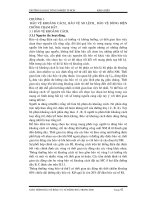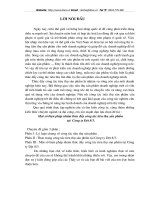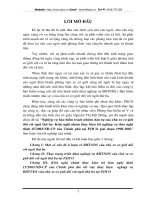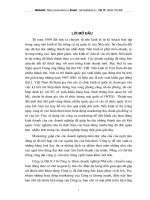lect 3 1113 props min2
Bạn đang xem bản rút gọn của tài liệu. Xem và tải ngay bản đầy đủ của tài liệu tại đây (2.78 MB, 40 trang )
Minerals II: Physical Properties and Crystal Forms
From: />
The Physical Properties of Minerals
•
•
•
•
•
•
Color
Streak
Luster
Hardness
External Crystal Form
Cleavage
The Physical Properties of Minerals (cont.)
•
•
•
•
•
Fracture
Specific Gravity
Special Properties
Other Properties
Chemical Tests
Physical properties of minerals
• Based on the principles discussed during the last
lecture and above, we now know that minerals are
composed of atoms, arranged in a specific order,
with a well defined chemical composition. We
might expect then that the microscopic
variations in bond environment discussed
above, will also be manifested in
macroscopic physical and chemical
properties. This is indeed the case.
Important Physical Properties I
• Luster - This property describes the
appearance of reflected light from the
mineral's surface. Nonmetallic minerals are
described using the following terms:
vitreous, pearly, silky, resinous, and earthy.
Important Physical Properties II
• Color - Although an obvious feature, it is often
unreliable to use to determine the type of mineral.
– Color arises due to electronic transitions, often of trace
constituents, in the visible range of the EM spectrum.
For example, quartz is found in a variety of colors.
• Color of a mineral may be quite diagnostic for the
trace element and coordination number of its
bonding environment.
Hope Diamond: 44.5 carats
/>
Important Physical Properties III
• Streak - The color of a mineral in its
powdered form; obtained by rubbing the
mineral against an unglazed porcelain plate.
– Streak is usually less variable than color.
– Useful for distinguishing between minerals
with metallic luster.
Density and Specific Gravity
• Density - Defined as the mass divided by the
volume and normally designated by the Greek
letter, rho,
mass/volume; SI units: kg/m3 or kg m-3, but
geologists often use g/cm3 as the unit of choice.
• Specific Gravity - Ratio of the mass of a
substance to the mass of an equal volume of
water. Note that water = 1 g cm-3. S.G. is unitless.
• Examples - quartz (SiO2) has a S.G. of 2.65
while galena (PbS) has a S.G. of 7.5 and gold (Au)
has a S.G. of 19.3.
Color and Density
•
Two broad categories are ferromagnesian and
nonferromagnesian silicates , which simply means iron and magnesian
bearing or not. The presence or absence of Fe and Mg strongly affects the
external appearance (color) and density of the minerals.
•
Ferromagnesian silicates - dark color, density range from 3.2 - 3.6
g/cc
– Olivine - high T, low silica rocks; comprises over 50% of upper
mantle
– Pyroxenes - high T, low silica rocks
– Amphiboles - esp. hornblende; moderate T, higher silica rocks
– Mica - esp. biotite; moderate T, higher silica rocks
– Garnet - common metamorphic mineral
•
Nonferromagnesian silicates - light color, density close to 2.7 g/cc
– Mica - exp. muscovite; moderate T, higher silica rocks
– Feldspars - plagioclase and orthoclase; most common mineral in
crust; form over a wide range of temperatures and melt compositions
– Quartz - low T, high silica rocks; extremely stable at surface, hence it
Crustal Minerals
More Zoning
From />
Zoning in Plagioclase Feldspar
Na-rich rim
Ca-rich core
Important Physical Properties IV
• Crystal form or habit - The external
morphology of crystals generally reflect the
internal arrangement of their constituent atoms.
This can be obscured, however, if the mineral
crystallized in an environment that did not allow it
to grow without significant interaction with other
crystals (even of the same mineral).
Chrysotile Asbestos
Belongs to the Serpentine mineral family hydrated ferromagnesian silicate.
Crystal Forms: Quartz
Feldspar
Intergrown cubic crystals of fluorite
Quartz Interfacial Angles
Perfectly
Proportioned
Crystals
Misshapen
Crystals
Steno’s Law (1669): Crystal face internal angles remain constant!
Macroscopic Forms and Microscopic Blocks
Cubes
Macroscopic
Crystal Forms
Rhombs
Unit Cells and Crystal Structure
Cubic unit cell:
smallest repeatable unit
Important Physical Properties V
• Hardness - This is the resistance of the mineral
to abrasion or scratching. This property doesn't
vary greatly from sample to sample of the same
mineral, and thus is highly diagnostic. It also is a
direct reflection of the bonding type and internal
atomic arrangement. A value is obtained by
comparing the mineral to a standard scale devised
by Moh, which is comprised of 10 minerals
ranging in hardness from talc (softest) to
diamond (hardest).
Mohs’ Hardness Scale
Polymorphism and polymorphs
• Substances having the same chemical composition
but different crystal structures.
– e.g. diamond and graphite
• Both minerals are composed of pure carbon, but
diamond is the high pressure polymorph of
graphite.
• This gives rise to extremely different physical
properties.
Polymorphism
3 mm
Natural Octahedral Diamond
From: />
Graphite & Calcite









